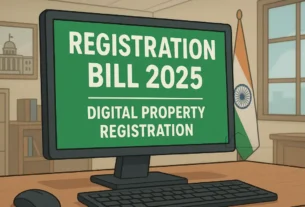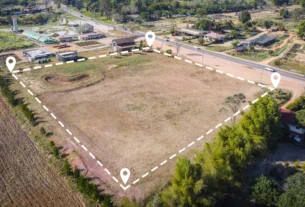Buying a property in India isn’t complete until it’s officially registered in your name. Property registration is a critical legal step that ensures ownership rights are transferred from the seller to the buyer. Without registration, you don’t have legal ownership—no matter how much you’ve paid.
In this article, we will explain the property registration process in India in a simple, step-by-step manner. From documentation and stamp duty to sub-registrar office procedures and recent digital changes, you’ll learn everything you need to know before registering a property in any Indian state.
What Is Property Registration?
Property registration in India refers to the process of recording the change in ownership of a property with the government. This is done under the provisions of the Registration Act, 1908. Once registered, the buyer’s name is officially entered into government records, which serves as proof of legal ownership.
It also provides legal protection in case of disputes, fraud, or property-related litigation.
Why Property Registration Is Important
Property registration is more than a formality. It protects both the buyer and seller in several ways:
- Legal Ownership: A registered document proves ownership.
- Prevent Disputes: It prevents future ownership claims from third parties.
- Tax Purposes: It is required for paying property taxes.
- Loan Eligibility: You need a registered title deed for home loans.
- Resale Clarity: Ensures clear title for future buyers.
Unregistered properties are at a high risk of legal and financial complications.
When Does Property Registration Happen?
Typically, property registration happens immediately after the sale agreement is executed and full payment is made to the seller. For under-construction properties, registration is done after the builder receives the completion certificate.
In India, property registration is conducted at the Sub-Registrar of Assurances office within the jurisdiction of the property’s location. This falls under the purview of the State Government’s Revenue or Registration Department.
Step-by-Step Property Registration Process in India
1. Preparation of the Sale Deed
The first step is the drafting of the sale deed, which is the legal document that transfers ownership from the seller to the buyer. This should be done by a licensed advocate or notary and printed on stamp paper of appropriate value.
2. Calculate Stamp Duty and Registration Charges
Every state in India has different stamp duty and registration fee rates.
- Stamp Duty: Typically ranges between 4% to 7% of the property value
- Registration Charges: Generally 1% of the property value
Some states offer rebates for women buyers or for first-time homeowners.
You can calculate the amount using online stamp duty calculators offered by most state portals.
3. Payment of Stamp Duty
Stamp duty can be paid through:
- E-stamping via SHCIL (Stock Holding Corporation of India)
- Purchase of physical stamp papers
- Franking (only in selected states)
E-stamping is now the most common and convenient method.
4. Schedule an Appointment with Sub-Registrar
The buyer and seller must visit the Sub-Registrar office for execution of the sale deed. Most states now offer online appointment systems to reduce waiting times. Carry all original documents and identification proofs.
5. Document Verification and Biometric Capture
At the registrar’s office:
- The documents are verified
- Biometric data (fingerprint and photograph) of both parties is taken
- Two witnesses must be present
6. Registration and Issuance of Receipt
Once the registrar verifies everything, the sale deed is officially registered. A registration number is assigned, and you’ll be issued a registration receipt. The original documents are returned after scanning and authentication.
You can later collect the certified copy or download the digital copy from the state portal.
List of Documents Required
To successfully complete the property registration process in India, the following documents are mandatory:
- Original sale deed (prepared on stamp paper)
- Previous property title documents (chain of ownership)
- Encumbrance certificate
- Identity proof of buyer and seller (Aadhaar, PAN, passport)
- PAN card (mandatory for transactions above ₹50 lakh)
- Passport-size photographs of buyer and seller
- Proof of stamp duty and registration payment
- Power of attorney (if applicable)
- Completion certificate (for new flats)
- Occupancy certificate
Timeline for Property Registration
The actual process at the registrar’s office usually takes a few hours, but scheduling and documentation may require 2–3 days. Digital services have streamlined this process, especially in states like Maharashtra, Karnataka, and Delhi.
Property Registration Charges by State (2025 Snapshot)
Here’s a quick comparison of stamp duty + registration charges in key states:
| State | Stamp Duty | Registration Fees |
|---|---|---|
| Maharashtra | 5% | 1% |
| Delhi | 6% (men), 4% (women) | 1% |
| Uttar Pradesh | 7% | 1% |
| Karnataka | 5.6% | 1% |
| Tamil Nadu | 7% | 1% |
| Gujarat | 4.9% | 1% |
Rates may vary by location and are subject to change. Always verify on the respective state’s registration portal.
E-Registration and Digital Advancements
In recent years, India has embraced digitization of property registration. Several state governments now offer partial or full e-registration services. Through these platforms, you can:
- Calculate and pay stamp duty online
- Upload documents
- Schedule appointment slots
- Track status of registration
- Download certified copies of registered documents
This has drastically reduced corruption, middlemen dependency, and delays.
Common Mistakes to Avoid During Property Registration
- Incorrect Stamp Duty Value – Always calculate based on circle rate or agreement value, whichever is higher.
- Missing Chain of Title – Ensure that the property has a clear title going back at least 30 years.
- Incomplete Documentation – All original documents and IDs must be verified before registration.
- No Encumbrance Certificate – This document proves the property is free from any legal liabilities.
- Skipping Legal Due Diligence – Always consult a property lawyer, especially in resale or disputed property transactions.
Difference Between Registered Sale Agreement vs Registered Sale Deed
A Registered Sale Agreement is usually executed before construction completion or final payment. It states that a property sale will take place, and protects buyer rights.
A Registered Sale Deed, on the other hand, is the final, legal transfer of ownership and must be registered with the sub-registrar to become legally enforceable.
Property Registration for NRIs
For Non-Resident Indians, property registration is similar to that of resident Indians, but certain provisions apply:
- PAN and Aadhaar are still required
- A power of attorney can be used to authorize someone locally
- Repatriation of funds from property sale must comply with FEMA guidelines
States like Maharashtra, Karnataka, and Kerala have streamlined NRI-friendly property registration systems with online document submission and appointments.
Post-Registration Checklist
After your property is registered:
- Collect certified copy of registered deed
- Apply for mutation of property in local municipal records
- Update property tax records in your name
- Inform your housing society or RWA
- Store all documents safely (digital + physical copies)
Conclusion
The property registration process in India may seem complicated, but once broken down, it becomes a logical and straightforward legal requirement. Whether you’re buying an apartment, house, or commercial space, registering your property ensures that your ownership is legally valid and secure.
From understanding stamp duty to navigating the sub-registrar process and avoiding common pitfalls, being informed helps you save time, avoid legal issues, and protect your investment.







